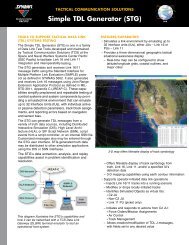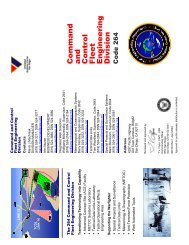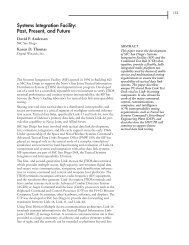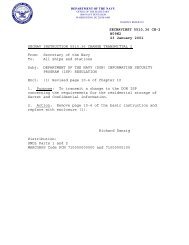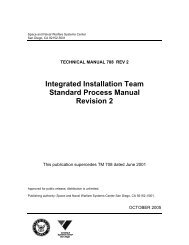Intelligence, Surveillance, and Reconnaissance - Spawar
Intelligence, Surveillance, and Reconnaissance - Spawar
Intelligence, Surveillance, and Reconnaissance - Spawar
Create successful ePaper yourself
Turn your PDF publications into a flip-book with our unique Google optimized e-Paper software.
176<br />
INTELLIGENCE, SURVEILLANCE, AND RECONNAISSANCE<br />
addressing, ranging, channel estimation, power control, <strong>and</strong> adaptive<br />
modulation [13]. Reliability is enhanced through the implementation of<br />
negative acknowledgements, range-dependent timers, retries, <strong>and</strong> automatic<br />
repeat requests [14].<br />
At the network layer, routing <strong>and</strong> navigation are accomplished through<br />
embedded data structures distributed throughout the network. Critical<br />
source-to-destination connectivity can be monitored through the use of<br />
receipt utility packets. The Seaweb server maintains these data structures,<br />
supports network configurability, manages network traffic at the gateways,<br />
<strong>and</strong> provides the graphical user interface for client workstations at<br />
manned comm<strong>and</strong> centers [15].<br />
Localized clusters of autonomous assets (e.g., sensors, crawlers, <strong>and</strong><br />
divers) assimilate through the formation of a Seaweb acoustic local area<br />
network (Sealan) covering an undersea region up to 5 km2 . A central<br />
Sealan node collects high-bit-rate, digital acoustic transmissions from the<br />
Sealan peripheral nodes. The sophisticated central node receives Sealan<br />
traffic with the processing gains afforded by coherent processing, adaptive<br />
equalization, spatial diversity, <strong>and</strong> beamforming. Received data pass<br />
to a host computer for local-area data fusion. Through asymmetric lowbit-rate<br />
backlinks, the central node can adapt the peripheral nodes to an<br />
evolving search-space situation <strong>and</strong> otherwise performs networking overhead<br />
functions, including ranging, localization, navigation, <strong>and</strong> remote<br />
control. The peripheral nodes may use the low-bit-rate link format for<br />
peer-to-peer communications, including network-layer token passing <strong>and</strong><br />
ranging. For undersea communications to beyond the local area, the<br />
Sealan central node uses Seaweb wide-area networking to cue neighboring<br />
Sealan central nodes, <strong>and</strong> to report events of interest to distant comm<strong>and</strong><br />
centers by using Seaweb’s decentralized wide-area networking.<br />
Sealan acoustic networks operate in a higher frequency b<strong>and</strong> <strong>and</strong> with<br />
different transducers. Therefore, the central node can maintain simultaneous<br />
Sealan <strong>and</strong> Seaweb communications without suffering interference.<br />
The centralized approach for local-area networks is identified as a solution<br />
consistent with the desire for information convergence <strong>and</strong> with the<br />
constraints of undersea acoustic propagation. The central node orchestrates<br />
the overall performance of the local sensors <strong>and</strong> communications<br />
<strong>and</strong> is the local interface to the wide-area deployment. Since high-bit-rate<br />
transmitter <strong>and</strong> low-bit-rate receiver are simple, the peripheral nodes can<br />
be inexpensive, small, <strong>and</strong> plentiful.<br />
EXPERIMENTAL IMPLEMENTATIONS<br />
Seaweb is implemented as Navy-restricted firmware operating on commercial<br />
modem hardware produced by Small Business Innovation<br />
Research (SBIR) contractor Benthos, Inc. Racom buoys are gateway<br />
nodes that have successfully incorporated line-of-sight FreeWave radios,<br />
cellular digital packet date (CDPD) telephone modems, Iridium satellite<br />
communications (SATCOM) modems, <strong>and</strong> Global Positioning System<br />
(GPS) receivers. Sublink capability has been implemented easily on<br />
WQC-2 <strong>and</strong> BSY-1 submarine sonar. A Seaweb server resides at manned<br />
comm<strong>and</strong> centers <strong>and</strong> is the interface to the undersea network.<br />
The power of Seaweb connectivity was successfully <strong>and</strong> dramatically<br />
demonstrated during recent Navy <strong>and</strong> international experiments. Figure 2<br />
is a chart of the Fleet Battle Experiment India (FBE-I) Seaweb network, a



